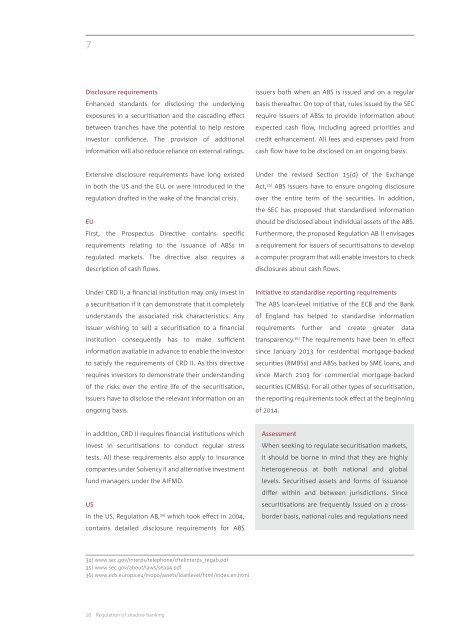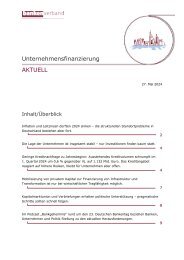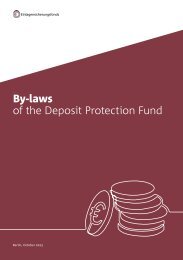Regulation of shadow banking
Shadow banking is given a large share of the blame for the financial crisis. This perception raises the question of what kind of shadow banking system should remain in place in the future.
Shadow banking is given a large share of the blame for the financial crisis. This perception raises the question of what kind of shadow banking system should remain in place in the future.
Create successful ePaper yourself
Turn your PDF publications into a flip-book with our unique Google optimized e-Paper software.
7<br />
Disclosure requirements<br />
Enhanced standards for disclosing the underlying<br />
exposures in a securitisation and the cascading effect<br />
between tranches have the potential to help restore<br />
investor confidence. The provision <strong>of</strong> additional<br />
information will also reduce reliance on external ratings.<br />
issuers both when an ABS is issued and on a regular<br />
basis thereafter. On top <strong>of</strong> that, rules issued by the SEC<br />
require issuers <strong>of</strong> ABSs to provide information about<br />
expected cash flow, including agreed priorities and<br />
credit enhancement. All fees and expenses paid from<br />
cash flow have to be disclosed on an ongoing basis.<br />
Extensive disclosure requirements have long existed<br />
in both the US and the EU, or were introduced in the<br />
regulation drafted in the wake <strong>of</strong> the financial crisis.<br />
EU<br />
First, the Prospectus Directive contains specific<br />
requirements relating to the issuance <strong>of</strong> ABSs in<br />
regulated markets. The directive also requires a<br />
description <strong>of</strong> cash flows.<br />
Under the revised Section 15(d) <strong>of</strong> the Exchange<br />
Act, 35) ABS issuers have to ensure ongoing disclosure<br />
over the entire term <strong>of</strong> the securities. In addition,<br />
the SEC has proposed that standardised information<br />
should be disclosed about individual assets <strong>of</strong> the ABS.<br />
Furthermore, the proposed <strong>Regulation</strong> AB II envisages<br />
a requirement for issuers <strong>of</strong> securitisations to develop<br />
a computer program that will enable investors to check<br />
disclosures about cash flows.<br />
Under CRD II, a financial institution may only invest in<br />
a securitisation if it can demonstrate that it completely<br />
understands the associated risk characteristics. Any<br />
issuer wishing to sell a securitisation to a financial<br />
institution consequently has to make sufficient<br />
information available in advance to enable the investor<br />
to satisfy the requirements <strong>of</strong> CRD II. As this directive<br />
requires investors to demonstrate their understanding<br />
<strong>of</strong> the risks over the entire life <strong>of</strong> the securitisation,<br />
issuers have to disclose the relevant information on an<br />
ongoing basis.<br />
Initiative to standardise reporting requirements<br />
The ABS loan-level initiative <strong>of</strong> the ECB and the Bank<br />
<strong>of</strong> England has helped to standardise information<br />
requirements further and create greater data<br />
transparency. 36) The requirements have been in effect<br />
since January 2013 for residential mortgage-backed<br />
securities (RMBSs) and ABSs backed by SME loans, and<br />
since March 2103 for commercial mortgage-backed<br />
securities (CMBSs). For all other types <strong>of</strong> securitisation,<br />
the reporting requirements took effect at the beginning<br />
<strong>of</strong> 2014.<br />
In addition, CRD II requires financial institutions which<br />
invest in securitisations to conduct regular stress<br />
tests. All these requirements also apply to insurance<br />
companies under Solvency II and alternative investment<br />
fund managers under the AIFMD.<br />
US<br />
In the US, <strong>Regulation</strong> AB, 34) which took effect in 2004,<br />
contains detailed disclosure requirements for ABS<br />
Assessment<br />
When seeking to regulate securitisation markets,<br />
it should be borne in mind that they are highly<br />
heterogeneous at both national and global<br />
levels. Securitised assets and forms <strong>of</strong> issuance<br />
differ within and between jurisdictions. Since<br />
securitisations are frequently issued on a crossborder<br />
basis, national rules and regulations need<br />
34) www.sec.gov/interps/telephone/cftelinterps_regab.pdf<br />
35) www.sec.gov/about/laws/sea34.pdf<br />
36) www.ecb.europa.eu/mopo/assets/loanlevel/html/index.en.html<br />
28 <strong>Regulation</strong> <strong>of</strong> <strong>shadow</strong> <strong>banking</strong>


















